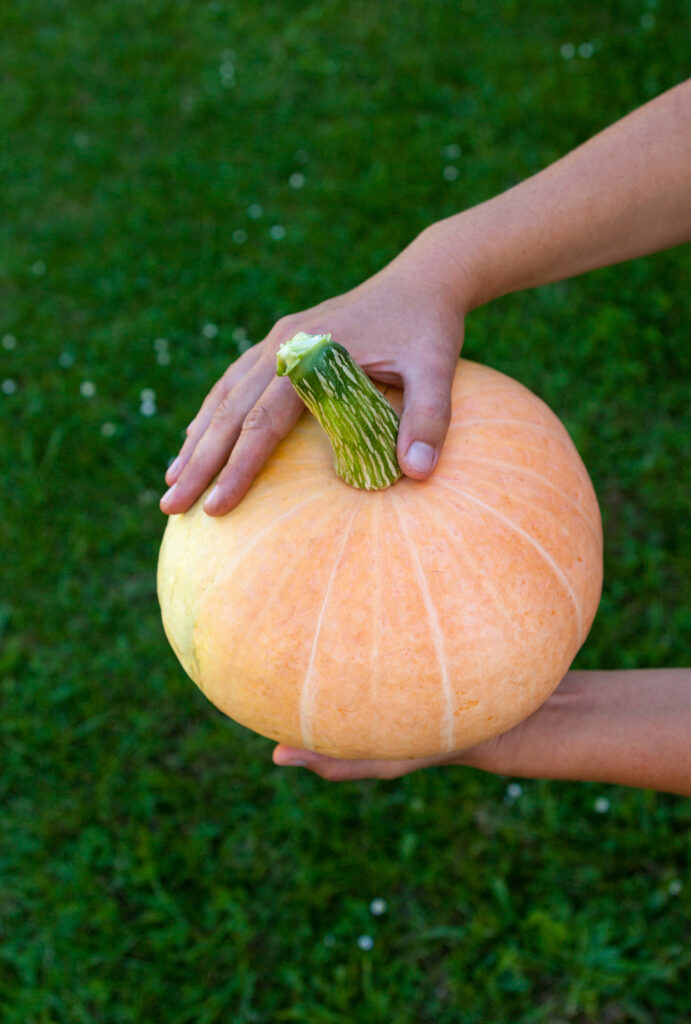Think you need a sprawling backyard to grow pumpkins? Think again! With the right container and a compact variety, you can enjoy homegrown pumpkins even on a patio or balcony. Here’s my guide to growing pumpkins in containers, including choosing the right size pot, the best soil mix, and essential care tips.
Can You Really Grow Pumpkins in Containers?
Pumpkins are traditionally known as space-hungry plants, with vines that can sprawl for 10 feet or more. For that reason, many gardeners think container-growing is impossible.
But with experience, I’ve found you can grow small pumpkin varieties successfully in containers—with a few important strategies:
- Choose the right pumpkin variety (more on that below).
- Use a large enough container (minimum 10 gallons).
- Provide consistent water and nutrients.
- Train the vines to grow neatly around the pot to save space.
I’ve grown container pumpkins on patios and decks where a garden bed wasn’t available, and the results have been surprisingly rewarding.
Choosing the Right Container
Pumpkins need room for both their roots and their vines.
I recommend using at least a 10-gallon container for a single small pumpkin plant. Even bigger—like 15 or 20 gallons—is better if you have the space.
Tips for the container:
- Choose one with drainage holes to prevent soggy soil.
- Use fabric grow bags, half-barrels, or heavy-duty plastic pots.
- Position the container where it gets at least 6 to 8 hours of sun daily.
I’ve had great success using fabric grow bags, which allow for excellent drainage and air-pruning of roots.
Best Pumpkin Varieties for Containers
Not all pumpkins are suited for small-space growing. Look for bush types or compact vining varieties. Here are some of my personal favorites:
- ‘Jack Be Little’ – Tiny ornamental pumpkins, perfect for containers.
- ‘Baby Boo’ – A mini white pumpkin with compact vines.
- ‘Bushkin’ – A true pumpkin-sized fruit on a bushy plant.
- ‘Spirit’ – A semi-bush variety that produces small to medium pumpkins.
These varieties are manageable and won’t overwhelm your container setup.

Soil and Planting Tips
Pumpkins are heavy feeders, so soil quality is key.
Use a rich, well-draining potting mix. I like to mix:
- 2 parts high-quality potting soil
- 1 part compost
- A handful of slow-release organic fertilizer (balanced 5-5-5)
Plant one seed or seedling per container. Bury the seed about 1 inch deep. If transplanting a seedling, be gentle with the roots.
Pro Tip from My Experience:
Pre-warming the soil by placing the container in a sunny spot for a few days before planting can help seeds germinate faster.
Watering and Feeding Container Pumpkins
Container soil dries out faster than garden soil.
Keep the soil evenly moist throughout the growing season—never let it dry out completely.
During hot spells, I check my pumpkins daily. Sometimes they need watering twice a day when temperatures soar.
Feeding schedule:
- Apply compost tea or diluted fish emulsion every two weeks.
- As fruits set, switch to a bloom-boosting fertilizer higher in phosphorus (like 5-10-5) to encourage fruit development.
Regular feeding has been the key to my best container pumpkin harvests.
Training the Vines
Even compact varieties send out vines! To keep things tidy:
- Gently coil the vines around the container.
- Use soft ties to guide them along a tomato cage, small trellis, or around the pot.
- Pinch back excessive vine growth if it becomes unmanageable.
Training vines conserves space and keeps the plant healthier by improving air circulation.
Harvesting Pumpkins in Containers
Depending on the variety, pumpkins are ready to harvest about 90 to 120 days after planting.
Signs it’s time to harvest:
- The pumpkin’s skin has hardened and turned the expected color.
- The vine begins to wither near the fruit.
Cut the pumpkin from the vine, leaving a few inches of stem attached. Letting pumpkins cure in the sun for a few days toughens their skin and extends storage life.
Final Thoughts
Growing pumpkins in containers might seem ambitious, but with the right techniques, it’s a fun and rewarding project.
Start small, choose the right variety, and stay consistent with watering and feeding. In my experience, few things are as satisfying as harvesting your own plump, colorful pumpkins right off your balcony or patio!
Related Posts Start Here:
Getting Started
- Pumpkin Varieties You’ll Love to Grow
- Choosing the Right Pumpkin: Cooking vs Carving
- Pumpkin Seed Starting Tips
- How to Plant Pumpkins Successfully
- How to Grow Pumpkins in Containers
- Best Companion Plants for Pumpkins
Growing and Care
- Watering, Feeding, and Caring for Pumpkins: A Complete Guide
- Pumpkin Pollination: A Gardener’s Guide
- Common Pumpkin Pests and Diseases (and How to Stop Them)
Harvest and Beyond
- How and When to Harvest Pumpkins
- How to Store and Preserve Pumpkins After Harvest
- Five Ways to Cook Pumpkins
Bonus/Fun


